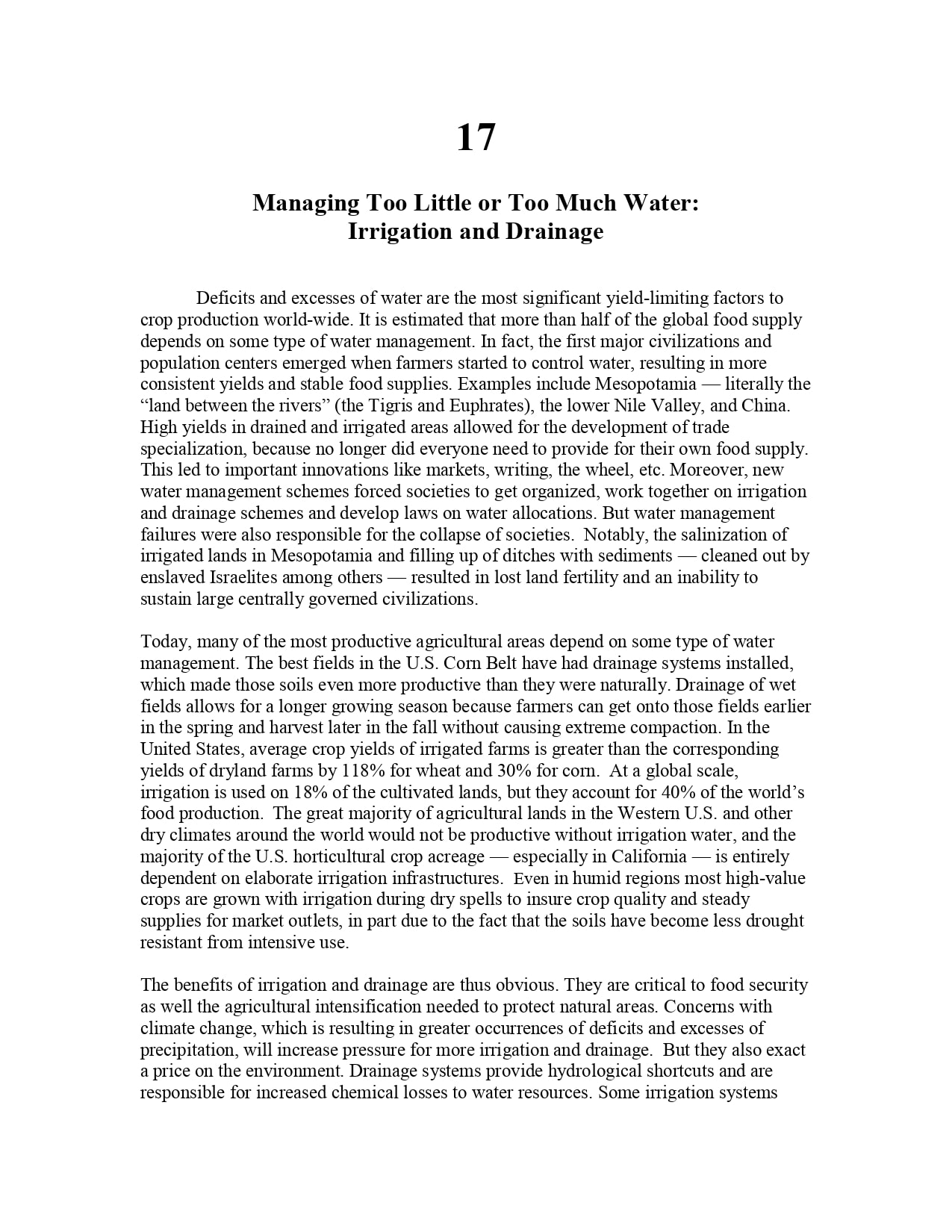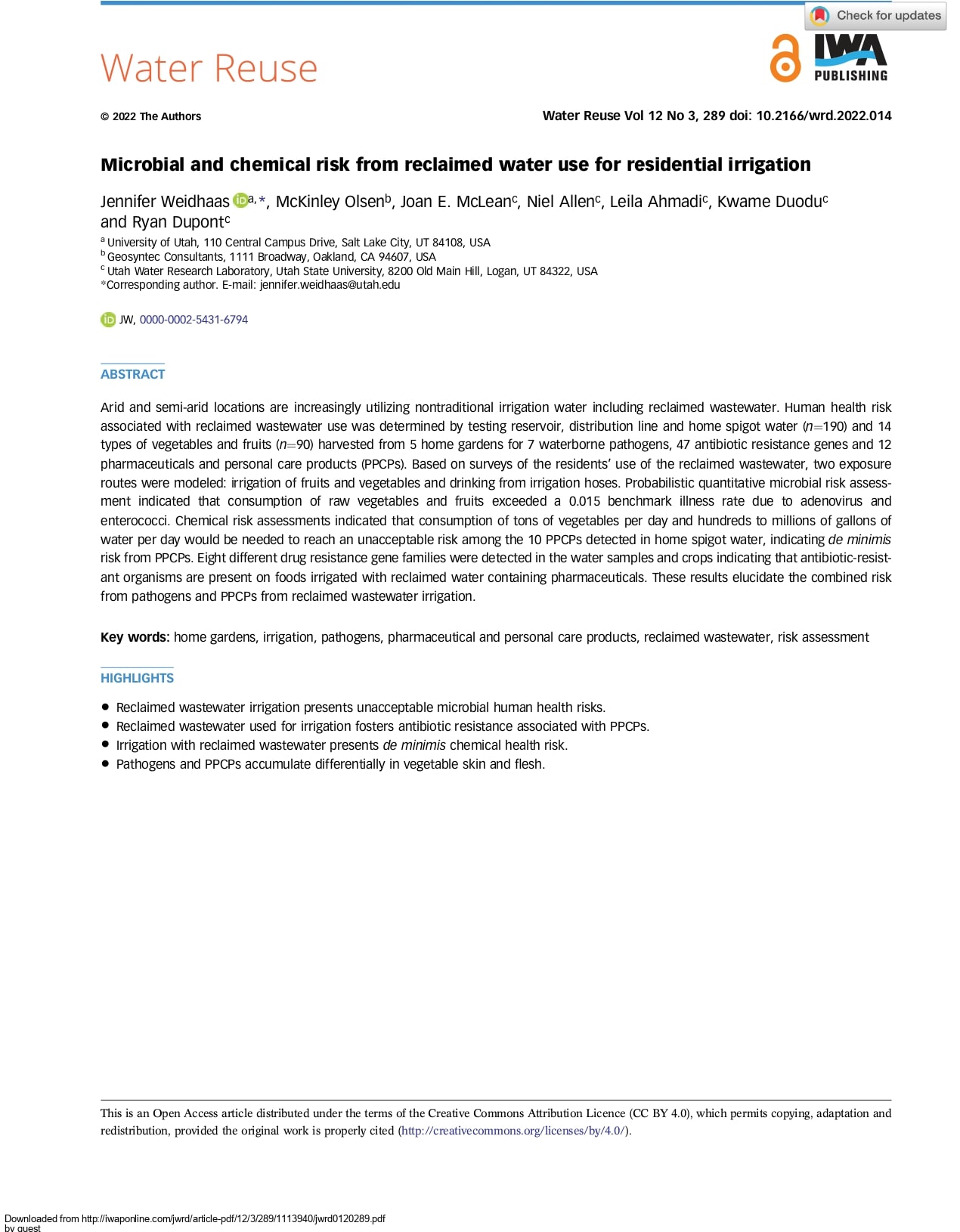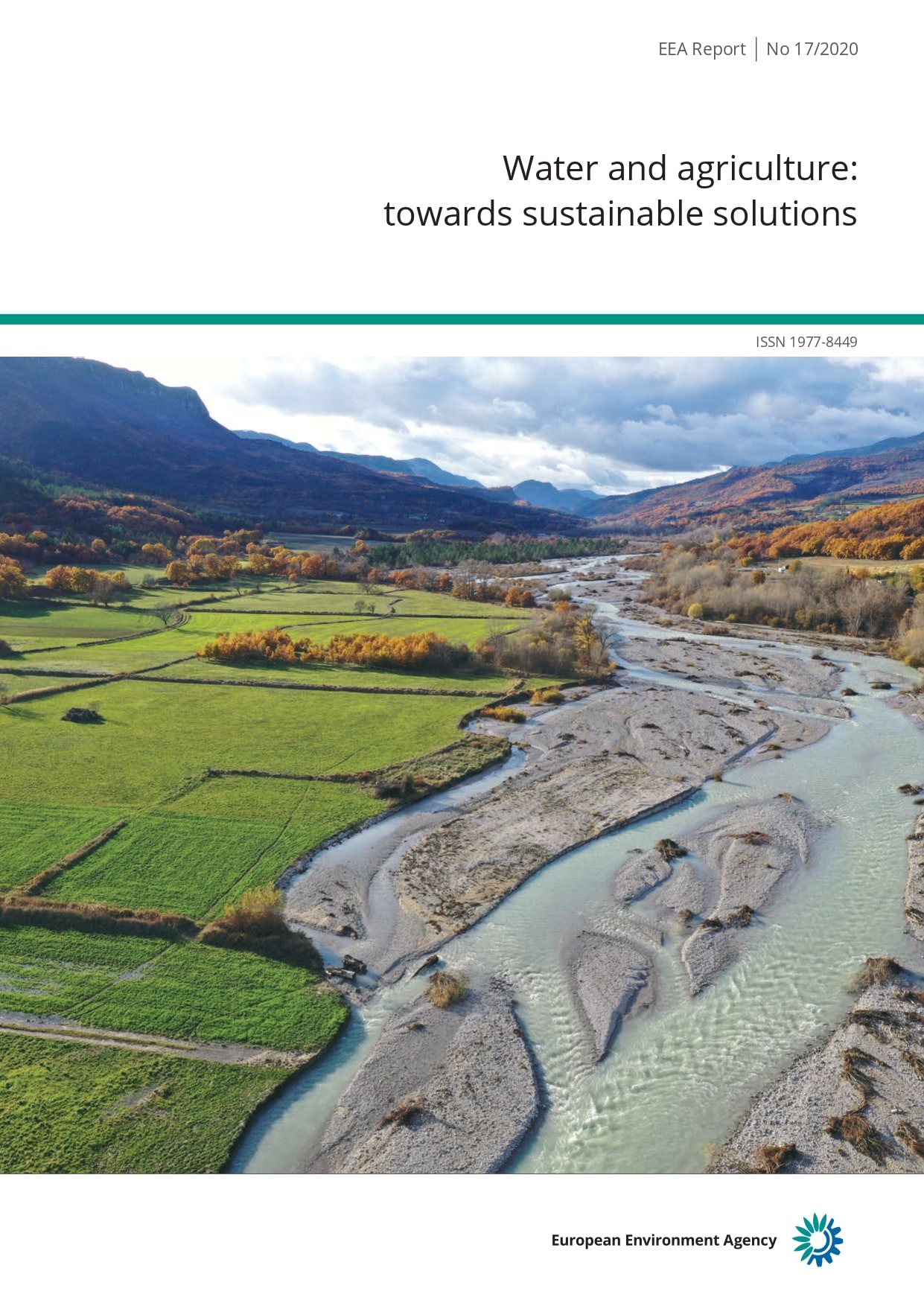Technical Guidance Water Reuse Risk Management for Agricultural Irrigation Schemes in Europe
Technical Guidance Water Reuse Risk Management for Agricultural Irrigation Schemes in Europe
Source: https://commission.europa.eu/index_en
Usually dispatched in 2 to 3 days
Usually dispatched in 2 to 3 days
Category:
Irrigation & Agriculture
In the context of the new Circular Economy Action Plan that was adopted in 2020, the Regulation 741/2020 on minimum requirements for water reuse for agricultural irrigation aims to boost water reuse practices in Europe.
Only logged in customers who have purchased this product may leave a review.
Related products
Wastewater Use in Agriculture
Introduction
With increasing global population, the gap between the supply and demand for water is widening and is reaching such alarming levels that in some parts of the world it is posing a threat to human existence. Scientists around the globe are working on new ways of conserving water. It is an opportune time, to refocus on one of the ways to recycle water—through the reuse of urban wastewater, for irrigation and other purposes. This could release clean water for use in other sectors that need fresh water and provide water to sectors that can utilize wastewater e.g., for irrigation and other ecosystem services. In general, wastewater comprises liquid wastes generated by households, industry, commercial sources, as a result of daily usage, production, and consumption activities. Municipal treatment facilities are designed to treat raw wastewater to produce a liquid effluent of suitable quality that can be disposed to the natural surface waters with minimum impact on human health or the environment. The disposal of wastewater is a major problem faced by municipalities, particularly in the case of large metropolitan areas, with limited space for land[1]based treatment and disposal. On the other hand, wastewater is also a resource that can be applied for productive uses since wastewater contains nutrients that have the potential for use in agriculture, aquaculture, and other activities. In both developed and developing countries, the most prevalent practice is the application of municipal wastewater (both treated and untreated) to land. In developed countries where environmental standards are applied, much of the wastewater is treated prior to use for irrigation of fodder, fiber, and seed crops and, to a limited extent, for the irrigation of orchards, vineyards, and other crops. Other important uses of wastewater include, recharge of groundwater, landscaping (golf courses, freeways, playgrounds, schoolyards, and parks), industry, construction, dust control, wildlife habitat improvement and aquaculture. In developing countries, though standards are set, these are not always strictly adhered to. Wastewater, in its untreated form, is widely used for agriculture and aquaculture and has been the practice for centuries in countries such as China, India and Mexico. Thus, wastewater can be considered as both a resource and a problem. Wastewater and its nutrient content can be used extensively for irrigation and other ecosystem services. Its reuse can deliver positive benefits to the farming community, society, and municipalities. However, wastewater reuse also exacts negative externality effects on humans and ecological systems, which need to be identified and assessed. Before one can endorse wastewater irrigation as a means of increasing water supply for agriculture, a thorough analysis must be undertaken from an economic perspective as well. In this regard the comprehensive costs and benefits of such wastewater reuse should be evaluated. Conventional cost benefit analysis quite often fails to quantify and monetize externalities associated with wastewater reuse. Hence, environmental valuation techniques and other related tools should be employed to guide decision-making. Moreover, the economic effects of wastewater irrigation need to be evaluated not only from the social, economic, and ecological standpoint, but also from the sustainable development perspective. Pakistan is a case which illustrates this problem. Both treated and untreated municipal wastewater in the vicinity of large cities like Faisalabad is used for vegetable production. But, how safe is this practice? How does one tradeoff between the obvious benefits of this use and the costs associated with it?
Wastewater Use in Agriculture
Introduction
With increasing global population, the gap between the supply and demand for water is widening and is reaching such alarming levels that in some parts of the world it is posing a threat to human existence. Scientists around the globe are working on new ways of conserving water. It is an opportune time, to refocus on one of the ways to recycle water—through the reuse of urban wastewater, for irrigation and other purposes. This could release clean water for use in other sectors that need fresh water and provide water to sectors that can utilize wastewater e.g., for irrigation and other ecosystem services. In general, wastewater comprises liquid wastes generated by households, industry, commercial sources, as a result of daily usage, production, and consumption activities. Municipal treatment facilities are designed to treat raw wastewater to produce a liquid effluent of suitable quality that can be disposed to the natural surface waters with minimum impact on human health or the environment. The disposal of wastewater is a major problem faced by municipalities, particularly in the case of large metropolitan areas, with limited space for land[1]based treatment and disposal. On the other hand, wastewater is also a resource that can be applied for productive uses since wastewater contains nutrients that have the potential for use in agriculture, aquaculture, and other activities. In both developed and developing countries, the most prevalent practice is the application of municipal wastewater (both treated and untreated) to land. In developed countries where environmental standards are applied, much of the wastewater is treated prior to use for irrigation of fodder, fiber, and seed crops and, to a limited extent, for the irrigation of orchards, vineyards, and other crops. Other important uses of wastewater include, recharge of groundwater, landscaping (golf courses, freeways, playgrounds, schoolyards, and parks), industry, construction, dust control, wildlife habitat improvement and aquaculture. In developing countries, though standards are set, these are not always strictly adhered to. Wastewater, in its untreated form, is widely used for agriculture and aquaculture and has been the practice for centuries in countries such as China, India and Mexico. Thus, wastewater can be considered as both a resource and a problem. Wastewater and its nutrient content can be used extensively for irrigation and other ecosystem services. Its reuse can deliver positive benefits to the farming community, society, and municipalities. However, wastewater reuse also exacts negative externality effects on humans and ecological systems, which need to be identified and assessed. Before one can endorse wastewater irrigation as a means of increasing water supply for agriculture, a thorough analysis must be undertaken from an economic perspective as well. In this regard the comprehensive costs and benefits of such wastewater reuse should be evaluated. Conventional cost benefit analysis quite often fails to quantify and monetize externalities associated with wastewater reuse. Hence, environmental valuation techniques and other related tools should be employed to guide decision-making. Moreover, the economic effects of wastewater irrigation need to be evaluated not only from the social, economic, and ecological standpoint, but also from the sustainable development perspective. Pakistan is a case which illustrates this problem. Both treated and untreated municipal wastewater in the vicinity of large cities like Faisalabad is used for vegetable production. But, how safe is this practice? How does one tradeoff between the obvious benefits of this use and the costs associated with it?
Water Productivity of Irrigated Agriculture in India Potential areas for improvement
Abstract
The objective of this paper is to estimate water productivity in irrigated agriculture in selected basins in India; and to identify the drivers of change in water productivity in these regions.
Water Productivity of Irrigated Agriculture in India Potential areas for improvement
Abstract
The objective of this paper is to estimate water productivity in irrigated agriculture in selected basins in India; and to identify the drivers of change in water productivity in these regions.
Water and Agriculture: Towards Sustainable Solutions
The main pressures from agriculture are linked to diffuse pollution from nutrients and chemicals, water abstraction and hydromorphological changes. Often several pressures act at the same time, potentially increasing the range of ecological impacts. According to information reported under the WFD, around one third of surface water bodies fail to achieve good status because of one or several of these pressures.
Water and Agriculture: Towards Sustainable Solutions
The main pressures from agriculture are linked to diffuse pollution from nutrients and chemicals, water abstraction and hydromorphological changes. Often several pressures act at the same time, potentially increasing the range of ecological impacts. According to information reported under the WFD, around one third of surface water bodies fail to achieve good status because of one or several of these pressures.
The Green Side of the Water Cycle: New Advances in the Study of Plant Water Dynamics
Precision irrigation is becoming a crucial management approach for environmentally and
economically sustainable fruit tree production. The vast majority of fruit crops need irrigation
supply as rainfall does not match crop water requirements (Stöckle et al., 2011; Snyder, 2017).
In most cases of fruit crops cultivated in dry areas, rainfed agriculture is not sustainable and
deficit irrigation (DI) is a reasonable strategy to improve water use efficiency. Fereres and
Soriano (2007) highlighted the benefits of regulated DI as a strategy to reduce agricultural
water use. The main purpose of regulated DI is to reduce irrigation at specific developmental
stages of the crop with no or limited effects on yield. The use of DI in different phenological
stages of fruit crops started in the 1980s by Chalmers et al. (1981, 1986).
The Green Side of the Water Cycle: New Advances in the Study of Plant Water Dynamics
Precision irrigation is becoming a crucial management approach for environmentally and
economically sustainable fruit tree production. The vast majority of fruit crops need irrigation
supply as rainfall does not match crop water requirements (Stöckle et al., 2011; Snyder, 2017).
In most cases of fruit crops cultivated in dry areas, rainfed agriculture is not sustainable and
deficit irrigation (DI) is a reasonable strategy to improve water use efficiency. Fereres and
Soriano (2007) highlighted the benefits of regulated DI as a strategy to reduce agricultural
water use. The main purpose of regulated DI is to reduce irrigation at specific developmental
stages of the crop with no or limited effects on yield. The use of DI in different phenological
stages of fruit crops started in the 1980s by Chalmers et al. (1981, 1986).
Modelling and Management of Irrigation System
Irrigation is becoming an activity of precision, where combining information collected from various sources is necessary to optimally manage resources. New management strategies, such as big data techniques, sensors, artificial intelligence, unmanned aerial vehicles (UAV), and new technologies in general, are becoming more relevant every day. As such, modeling techniques, both at the water distribution network and the farm levels, will be essential to gather information from various sources and offer useful recommendations for decision-making processes. In this book, 10 high quality papers were selected that cover a wide range of issues that are relevant to the different aspects related to irrigation management: water source and distribution network, plot irrigation systems, and crop water management.
Modelling and Management of Irrigation System
Irrigation is becoming an activity of precision, where combining information collected from various sources is necessary to optimally manage resources. New management strategies, such as big data techniques, sensors, artificial intelligence, unmanned aerial vehicles (UAV), and new technologies in general, are becoming more relevant every day. As such, modeling techniques, both at the water distribution network and the farm levels, will be essential to gather information from various sources and offer useful recommendations for decision-making processes. In this book, 10 high quality papers were selected that cover a wide range of issues that are relevant to the different aspects related to irrigation management: water source and distribution network, plot irrigation systems, and crop water management.
Watering Floodplain Wetlands in the Murray–Darling Basin to Benefit Native Fish A Discussion with Managers
This report describes the content and outcomes of a workshop entitled ‘Watering Floodplain Wetlands of the Murray–Darling Basin for Fish: A Discussion with Managers’ held on 5 March 2008 at Wonga Wetlands in Albury (NSW). The workshop was part of a four-year, National Water Commission funded project aimed at optimizing wetland environmental watering protocols to maximize benefits to native fish populations.
Watering Floodplain Wetlands in the Murray–Darling Basin to Benefit Native Fish A Discussion with Managers
This report describes the content and outcomes of a workshop entitled ‘Watering Floodplain Wetlands of the Murray–Darling Basin for Fish: A Discussion with Managers’ held on 5 March 2008 at Wonga Wetlands in Albury (NSW). The workshop was part of a four-year, National Water Commission funded project aimed at optimizing wetland environmental watering protocols to maximize benefits to native fish populations.















Reviews
There are no reviews yet.